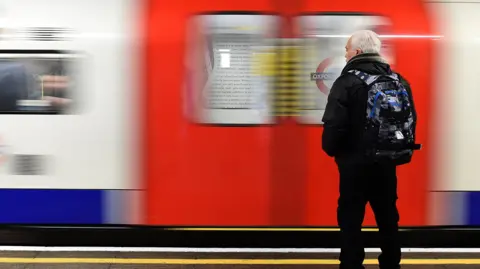Nearly £30m spent on Tube noise cuts over five years
 EPA
EPANew data from City Hall shows nearly £30m has been spent over the past five years on reducing noise on the London Underground.
The London mayor's office and Transport for London (TfL) said they had spent approximately £115m on general rail track improvements every year, with much of this work resulting in rail noise reductions.
The figure covers all "rail grinding" on the Tube network - managing defects and to prolong rail life, as well as specifically for the purpose of noise reduction.
They said the amount spent on rail noise reduction specifically has been reducing over the past five years, with "more efficiency resulting in a reduction in the costs of grinding per metre".
Rail grinding removes the bumps and dents from tracks that contribute to increases in screeching noises as the train crosses them. It also keeps the rails lasting longer.
'Hazardous levels'
A total of £9.2m was spent on rail grinding in 2019-2020 compared to £6.3m in 2023-2024.
In 2020-2021 and 2021-2022, rail grinding was impacted by the pandemic, with £4.2m and £4m spent. Last year, 2022-2023, £5.9m was spent.
Last year, research published in the medical journal The Laryngoscope found Tube passengers were regularly exposed to "hazardous" levels of noise similar to those seen from power tools.
It found Tube passengers were "routinely and consistently" exposed to noise levels exceeding 80 decibels and, on some trains, more than 100 decibels.
The London Assembly's Environmental Committee warned of mental and physical impacts stemming from prolonged exposure to the loud noise, citing the study.
It asked for TfL to make noise data publicly available and to invest in track improvements, citing levels similar to chainsaws and aircrafts taking off.
There is no legal limit on the noise levels Tube trains can produce.
Listen to the best of BBC Radio London on Sounds and follow BBC London on Facebook, X and Instagram. Send your story ideas to [email protected]
